The passing of Duchess Marie of Saxe-Altenburg marks the end of an era in the royal family of Gotha. Known as the doyenne of Gotha, she was a stalwart figure in the royal household, having lived through significant historical events and witnessed the rise and fall of monarchies. Her life was a testament to the resilience and adaptability of the royal family, as she navigated the complexities of royal protocol and family dynamics.
Throughout her life, Duchess Marie was a symbol of tradition and continuity, upholding the values and customs of the royal family. Her dedication to her role and her family was unwavering, and she played a crucial part in preserving the legacy of the royal household. As the last surviving member of the royal family of Gotha, her passing leaves a void that can never be filled. Her memory will be cherished by those who knew her and by the many who admired her from afar.
what were the key achievements of Duchess Marie during her reign
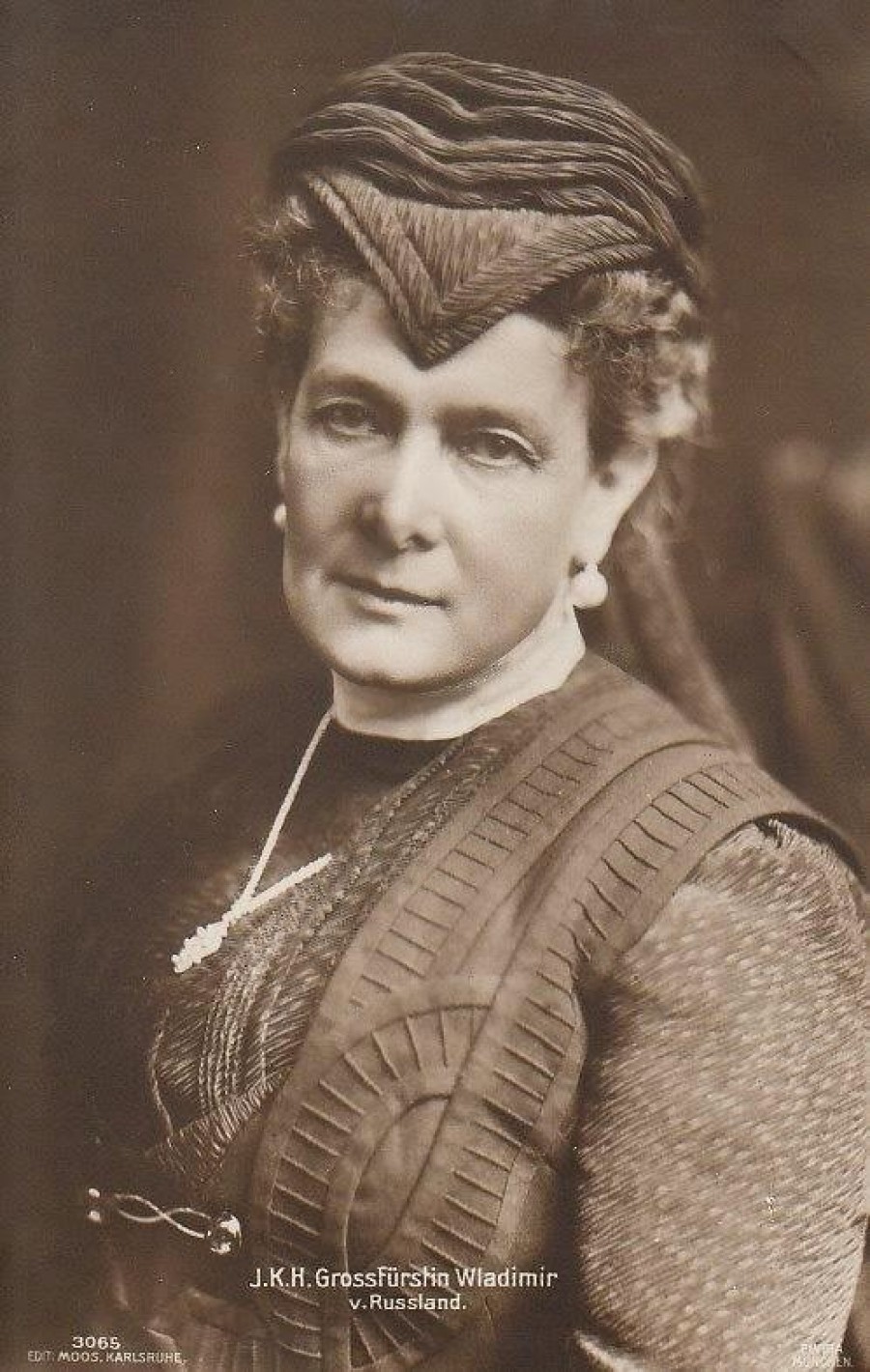
The key achievements of Duchess Marie during her reign include:
- Socially Minded Discourse: Duchess Marie-Adélaïde declared her interest in political and social affairs, emphasizing the importance of justice and fairness in her actions. She expressed her desire to protect the humble and the weak, and to work for rapprochement and solidarity.
- Accession to the Throne: At 17 years old, she succeeded her father as Grand Duchess of Luxembourg, becoming the first woman to occupy the Throne of Luxembourg since Empress Maria Theresa in 1780.
- Speech during Swearing-in Ceremony: Her speech during her swearing-in ceremony reflected her commitment to justice and fairness, highlighting her desire to judge in accordance with the requirements of justice and fairness.
- Abdication: She abdicated in favor of her sister Charlotte in 1919, following the revolutionary unrest and the occupation of Luxembourg by German troops during World War I.
- Legacy: Her legacy includes her dedication to her role and her family, as well as her efforts to preserve the traditions and customs of the royal household.
what were the major challenges Duchess Marie faced during her reign

Duchess Marie faced several significant challenges during her reign:
- Financial Crisis: The country was facing a severe financial crisis, which was exacerbated by her lavish spending and her husband’s involvement in the American Revolutionary War. This led to widespread discontent among the population and criticism of her perceived extravagance.
- Court Factionalism: The royal court was plagued by factionalism, with different groups vying for influence and power. This led to tensions and conflicts within the royal family and the court, making it difficult for Marie Antoinette to maintain a unified and effective administration.
- Public Perception: Marie Antoinette’s reputation suffered due to her association with the Austrian monarchy and her perceived influence over her husband’s decisions. This led to widespread distrust and resentment among the French people, who saw her as an outsider and a symbol of Austrian dominance.
- Personal Struggles: Marie Antoinette faced personal challenges, including the loss of her children, her husband’s disinterest in her, and her own struggles with her role as queen. These challenges took a toll on her mental and emotional well-being.
- French Revolution: The French Revolution, which began in 1789, posed a significant threat to the monarchy and the royal family. Marie Antoinette’s attempts to maintain her influence and protect her family were ultimately unsuccessful, and she was eventually executed in 1793.
- Court Scandals: The royal court was plagued by scandals, including accusations of infidelity and corruption. These scandals further eroded Marie Antoinette’s popularity and contributed to the growing discontent among the French people.
- Loss of Influence: As the French Revolution gained momentum, Marie Antoinette’s influence over her husband and the government diminished. She was eventually forced to abdicate in favor of her sister Charlotte in 1790.
These challenges, both personal and political, significantly impacted Marie Antoinette’s reign and ultimately contributed to the downfall of the French monarchy.
how did Duchess Marie’s personal life affect her reign
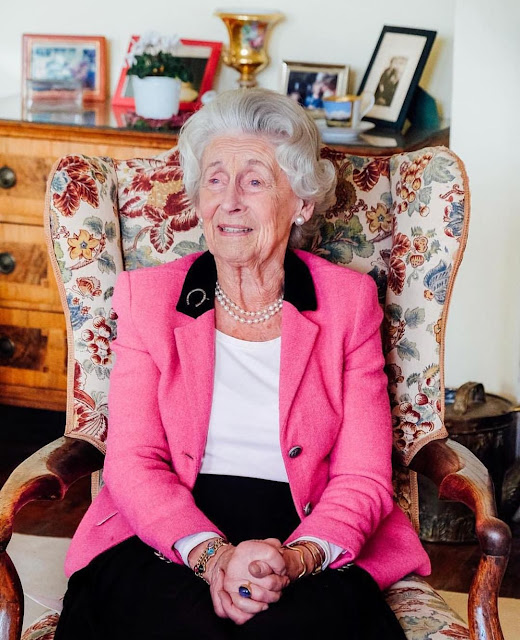 |
| Duchess Marie-Alix of Schleswig-Holstein on the occasion of her 95th birthday. Photo courtesy of Fürst Alexander zu Schaumburg-Lippe / Stiftung Louisenlund. |
On Monday, 1 November 2021, Dowager Duchess Marie-Alix of Schleswig-Holstein died peacefully at her home of Gut Bienebek in Holstein. She was ninety-eight years-old. The four children of the duchess were by her side when she died in her sleep; after her passing, the family released a brief statement: “In deep sorrow and full of love we say goodbye to our mother, grandmother and great-grandmother and look back on her eventful and fulfilled life with respect and immense gratitude.”
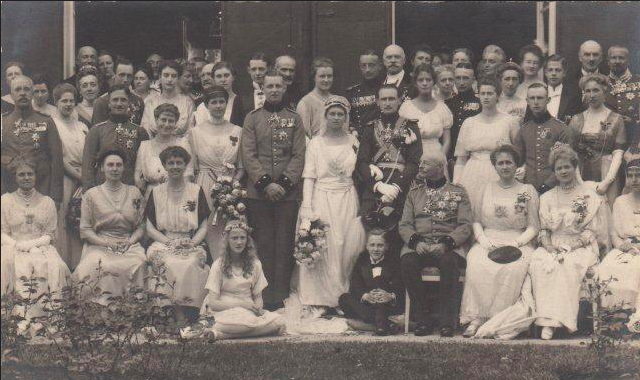 |
| The wedding of Prince Stephan zu Schaumburg-Lippe and Duchess Ingeborg of Oldenburg, 1921. |
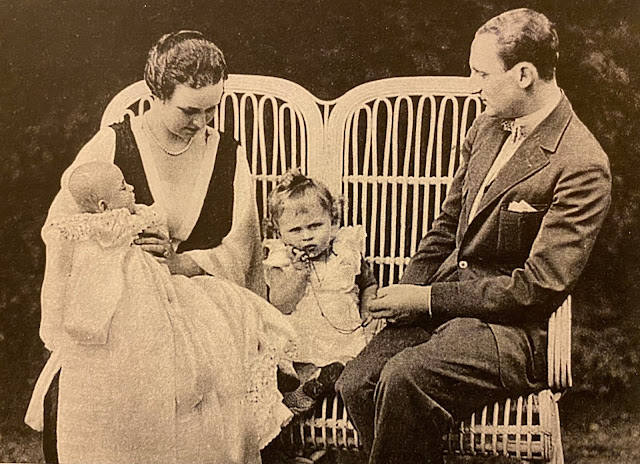 |
| Prince Stephan and Princess Ingeborg with Princess Marie-Alix and infant Prince Georg-Moritz. Photo (c) David McIntosh. |
Born on 2 April 1923 at Bückeburg, Princess Marie-Alix of Schaumburg-Lippe was the first child and only daughter of Prince Stephan of Schaumburg-Lippe (1891-1965) and Duchess Ingeborg of Oldenburg (1901-1996), who married in 1921. Marie-Alix was followed by a younger brother, Prince Georg-Moritz of Schaumburg-Lippe (1924-1970), who sadly was killed in a automobile accident at the age of forty-six. As her father Stephan was a German diplomat, Marie-Alix lived with her family in Sofia, Bulgaria; Rome, Italy; Rio de Janeiro, Brazil; Buenos Aires, Argentina; and Santiago, Chile. After the end of World War II, Marie-Alix spent time with her maternal Oldenburg relations in Lensahn, Ostholstein.
 |
| Fürst Georg zu Schaumburg-Lippe. |
 |
| Fürstin Marie zu Schaumburg-Lippe. |
 |
| Grand Duke Friedrich August II of Oldenburg. |
 |
| Grand Duchess Elisabeth of Oldenburg. |
The paternal grandparents of Marie-Alix were Fürst Georg of Schaumburg-Lippe (1846-1911) and his wife Princess Marie of Saxe-Altenburg (1864-1918). Her maternal grandparents were Grand Duke Friedrich August II of Oldenburg (1851-1932) and his second wife Duchess Elisabeth of Mecklenburg-Schwerin (1869-1955). Marie-Alix was a first cousin of Duke Anton-Günther of Oldenburg, Fürstin Eilika of Leiningen, Fürst Wittekind of Waldeck and Pyrmont, Fürstin Guda of Wied, and Fürst Philipp-Ernst of Schaumburg-Lippe.
 |
| Duke Peter of Schleswig-Holstein. Photo (c) David McIntosh. |
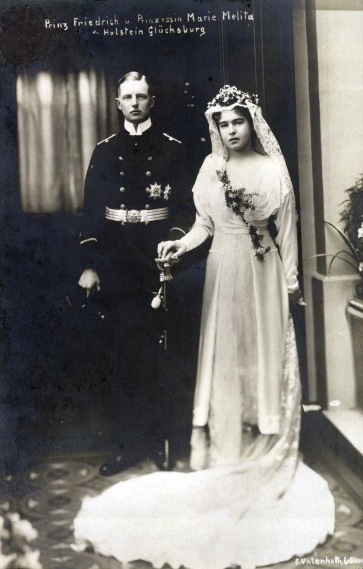 |
| Prince Friedrich Ferdinand zu Schaumburg-Lippe and Princess Marie Melita zu Hohenlohe-Langenburg on their wedding day. |
 |
| Left to right: Duke Friedrich Ferdinand, Prince Peter, and Princess Marie-Alix. Photo (c) David McIntosh. |
 |
| Left to right: Princess Marita, Prince Alexander, Duke Christoph, and Princess Ingeborg. Photo (c) David McIntosh. |
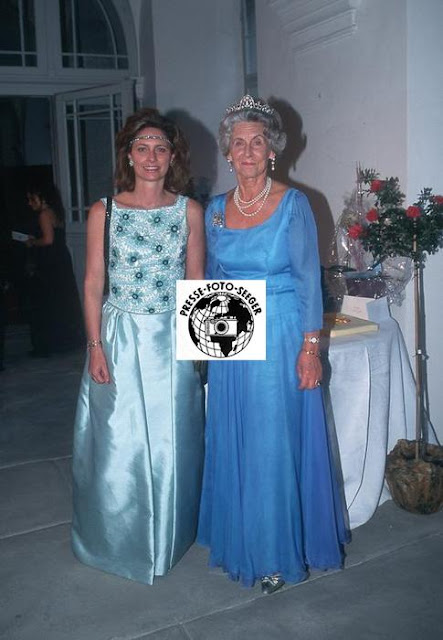 |
| Princess Barbara with her mother-in-law Duchess Marie-Alix at the wedding of Hereditary Prince Bernhard of Baden, 2001. Photo (c) Seeger-Presse. |
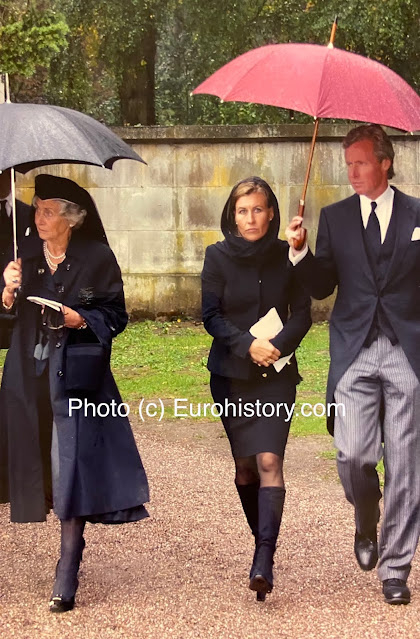 |
| Duchess Marie-Alix together with her son Duke Christoph and daughter-in-law Duchess Elisabeth attend the funeral of Fürst Philipp-Ernst zu Schaumburg-Lippe, 2003. |
 |
| Birthday cheers! Duchess Marie-Alix celebrates her 95th birthday surrounded by students of Louisenlund while her daughter Princess Ingeborg happily looks at her much loved mother. Photo (c) Stiftung Louisenlund. |
Duchess Marie-Alix of Schleswig-Holstein was a co-founder of the Louisenlund Foundation in 1949. This institution was envisioned by her father-in-law Duke Friedrich Ferdinand, and its mission was made a reality by continued support from her husband Duke Peter, her son Duke Christoph, and her daughter Princess Ingeborg. According to its website, Louisenlund “has created a school system with learning and teaching methods which prepare students for the future. To be equipped for the future students must develop social awareness and a strong personality. Since the very beginning, the private foundation, Louisenlund has strived to achieve a holistic education for its students. Moreover, Louisenlund is embedded in a network of international contacts and partner schools. Around 440 students benefit from an education in a global environment whilst enjoying, at the same time the familiar atmosphere of the campus.” Princess Ingeborg, the youngest child of the duchess, is the current chairperson of the foundation’s Board of Governors as well as of the Board of Trustees. The original uniform of Louisenlund students was created from a blue sweater out of Duke Friedrich Ferdinand’s wardrobe and a red sock from his daughter-in-law Duchess Marie-Alix’s closet which served as the collar.
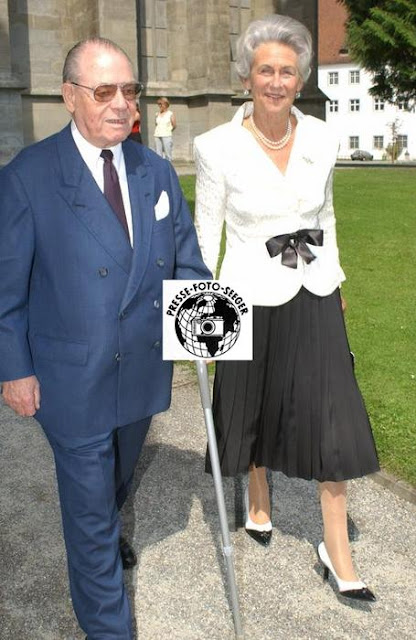 |
| Fürst Friedrich Wilhelm of Hohenzollern and Duchess Marie-Alix at the wedding of Hereditary Prince Bernhard of Baden, 2001. |
 |
| Duchess Marie-Alix with her children Princess Ingeborg and Duke Christoph attend the memorial service for Fürst Kraft zu Hohenlohe-Langenburg, 2004. |
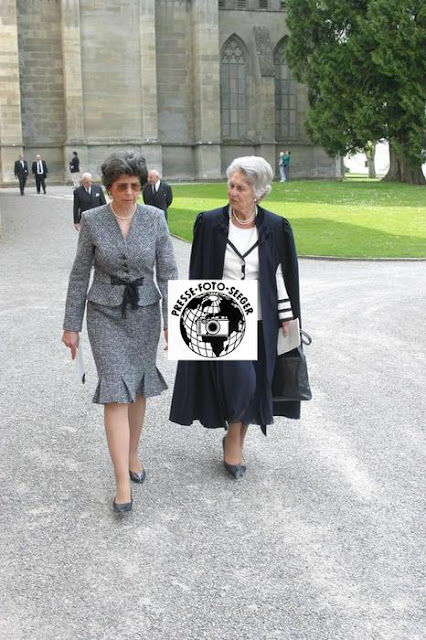 |
| Princess Marianne of Baden and Duchess Marie-Alix attend the funeral of Prince Georg Wilhelm of Hannover, 2006. Photo (c) Seeger-Presse. |
For many decades, Duchess Marie-Alix of Schleswig-Holstein was the Vice-President of the regional branch of the German Red Cross in Holstein. As shown by her dedication to the Louisenlund Foundation, the duchess was particularly keen on the betterment of young people and youth development.
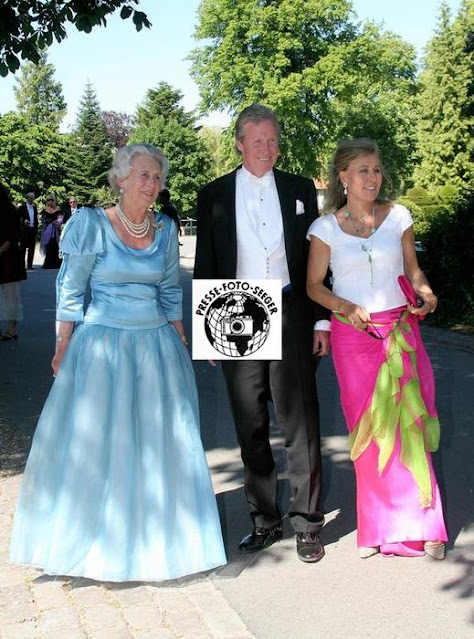 |
|
Duchess Marie-Alix, her son Duke Christoph, and her daugher-in-law Duchess Elisabeth at the wedding of Prince Philipp of Hesse, 2006.
Photo (c) Seeger-Presse / Albert Nieboer.
|
Duchess Marie-Alix of Schleswig-Holstein is survived by her four children, by her nine grandchildren, and by her (at least) five great-grandchildren.
what were the major events of Duchess Marie’s reign
The key achievements of Duchess Marie during her reign include:
- Socially Minded Discourse: Duchess Marie-Adélaïde declared her interest in political and social affairs, emphasizing the importance of justice and fairness in her actions. She expressed her desire to protect the humble and the weak, and to work for rapprochement and solidarity.
- Accession to the Throne: At 17 years old, she succeeded her father as Grand Duchess of Luxembourg, becoming the first woman to occupy the Throne of Luxembourg since Empress Maria Theresa in 1780.
- Speech during Swearing-in Ceremony: Her speech during her swearing-in ceremony reflected her commitment to justice and fairness, highlighting her desire to judge in accordance with the requirements of justice and fairness.
- Abdication: She abdicated in favor of her sister Charlotte in 1919, following the revolutionary unrest and the occupation of Luxembourg by German troops during World War I.
- Legacy: Her legacy includes her dedication to her role and her family, as well as her efforts to preserve the traditions and customs of the royal household.
As we bid farewell to the doyenne of Gotha, Duchess Marie, we are reminded of the significant impact she had on the royal family and the world at large. Her life was a testament to the power of resilience and dedication, as she navigated the complexities of royal protocol and family dynamics with unwavering commitment. Throughout her life, Duchess Marie was a symbol of tradition and continuity, upholding the values and customs of the royal household with unwavering dedication. Her legacy will continue to inspire future generations, serving as a reminder of the importance of perseverance and loyalty.
As we reflect on the life and reign of Duchess Marie, we are struck by the profound influence she had on those around her. Her unwavering commitment to her role and her family was a beacon of hope and stability in times of turmoil. Her dedication to preserving the traditions and customs of the royal household was a testament to her deep understanding of the importance of heritage and legacy. As we say goodbye to this remarkable woman, we are reminded of the enduring power of her legacy, which will continue to inspire and guide those who come after her. May her memory be a blessing to all who knew her, and may her legacy continue to inspire future generations to follow in her footsteps.
what were the main challenges Duchess Marie faced during her reign
Duchess Marie faced several significant challenges during her reign:
- Financial Crisis: The country was facing a severe financial crisis, which was exacerbated by her lavish spending and her husband’s involvement in the American Revolutionary War. This led to widespread discontent among the population and criticism of her perceived extravagance.
- Court Factionalism: The royal court was plagued by factionalism, with different groups vying for influence and power. This led to tensions and conflicts within the royal family and the court, making it difficult for Marie Antoinette to maintain a unified and effective administration.
- Public Perception: Marie Antoinette’s reputation suffered due to her association with the Austrian monarchy and her perceived influence over her husband’s decisions. This led to widespread distrust and resentment among the French people, who saw her as an outsider and a symbol of Austrian dominance.
- Personal Struggles: Marie Antoinette faced personal challenges, including the loss of her children, her husband’s disinterest in her, and her own struggles with her role as queen. These challenges took a toll on her mental and emotional well-being.
- French Revolution: The French Revolution, which began in 1789, posed a significant threat to the monarchy and the royal family. Marie Antoinette’s attempts to maintain her influence and protect her family were ultimately unsuccessful, and she was eventually executed in 1793.
- Court Scandals: The royal court was plagued by scandals, including accusations of infidelity and corruption. These scandals further eroded Marie Antoinette’s popularity and contributed to the growing discontent among the French people.
- Loss of Influence: As the French Revolution gained momentum, Marie Antoinette’s influence over her husband and the government diminished. She was eventually forced to abdicate in favor of her sister Charlotte in 1790.
These challenges, both personal and political, significantly impacted Marie Antoinette’s reign and ultimately contributed to the downfall of the French monarchy.
 Constantine and Anne-Marie of Greece: A Love Story for the Ages
Constantine and Anne-Marie of Greece: A Love Story for the Ages Grand Duchess Maria of Russia: A Life of Tragedy and Triumph
Grand Duchess Maria of Russia: A Life of Tragedy and Triumph Adieu to the Doyenne of Gotha: Duchess Marie’s Legacy Lives On
Adieu to the Doyenne of Gotha: Duchess Marie’s Legacy Lives On



